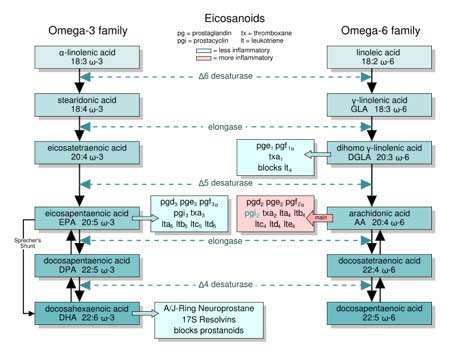Essential Fatty Acids & Pain / Inflammation Management
Most people by now are aware of the requirement for the essential fatty acids, other wise known as Omega 3, 6 and 9, in the diet. These are referred to as “essential” both due to the affects of excluding these form the diet and the fact they cannot be synthised in the body. Some examples of these essential fatty acids include:
- Alpha linolenic acid found in linseed (flaxseed), soybean and other seed oils;
- Linoleic acid found in Corn, safflower, soybean, cottonseed, sunflower seed, and peanut oil;
- Oleic acid found in plant and animal fats;
- Arachidonic acid found in animal fats;
The designation Omega 3, 6 and 9 refers to the position of the hydrogen double bond from the omega end of the chemical chain.
Now through a variety of biochemical pathways these essential fatty acids break down into prostaglandins, a hormone like substance that is pivotal in all the minute by minute reactions in the body. Some of these prostaglandins are responsible for with regulating blood pressure, inflammatory responses, insulin sensitivity, immune responses, anabolic/catabolic processes, and hundreds of other functions known and yet unknown.
So how is this relevant to those suffering from joint pain?
Much joint and back pain is due to inflammation of the tissues within and around the joint. By reducing the inflammation, pain will effectively be reduced. The table below shows the four characteristics of inflammation that you will find in any Anatomy & Physiology text book along with the prostaglandins that are involved in them.
| Redness | Short acting vasoconstrictors — TXA2—are released quickly after the injury. The site may momentarily turn pale. Then TXA2 mediates the release of the vasodilators PGE2 and LTB4. The blood vessels engorge and the injury reddens. |
| Swelling | LTB4 makes the blood vessels more permeable. Plasma leaks out into the connective tissues, and they swell. The process also looses pro-inflammatory cytokines. |
| Pain | The cytokines increase COX-2 activity. This elevates levels of PGE2, sensitizing pain neurons. |
| Heat | PGE2 is also a potent pyretic agent. Aspirin and NSAIDS—drugs that block the COX pathways and stop prostanoid synthesis—limit fever or the heat of localized inflammation. |
If you look at the below diagram you will quite easily see that all these prostaglandins mentioned are by products of chemical reactions involving the Omega 6 family of essential fatty acids.

On the flip side of this equation Omega 3 fatty acids, which include α-linolenic acid (ALA), eicosapentaenoic acid (EPA), and docosahexaenoic acid (DHA), are responsible for the formation of anti-inflammatory prostaglandins. As an added benefit, as you can see in the above diagram, Omega 3 fatty acids compete with Omega 6 fatty acids for enzymes at every step of the process.
There is a lot of evidence that suggests that our initial diet had a 1:1 to ratio of Omega 6:Omega 3. The modern western diet however has tilted very heavily towards Omega 6 with the current ratio being as high as 17:1. At the same time there is a corresponding increase in cardiovascular disease, cancer, and, not surprisingly, inflammatory and autoimmune diseases. We will leave you to do the math!
Increasingly, nutritionists are recommending increasing Omega 3 intake as a way to solve many problems. From a musculoskeletal perspective research has shown that for individuals with rheumatoid arthritis an Omega 6:Omega 3 ratio of 2–3:1 suppressed inflammation.
But where is this high intake of Omega 6 in our diets coming from and how do I get rid of it?
Firstly, some oils are particularly high in Omega 6 fatty acids. Try to eliminate some of the following oils from the diet;
- corn;
- sunflower;
- safflower;
- cottonseed;
- Soybean oil.
Many of our margarine’s, salad dressings and mayonnaise are made from these omega-6 rich oils. These oils are also used in our fast food industry where Soybean oil is fast becoming one of the most frequently used oils for frying.
It’s also important to review what the oils are being used to cook. Beef for example has a high concentration of Omega 6. Various reports show anything from a 4:1 to 2:1 ration of omega 6 to omega 3 fatty acids in beef, depending on whether it was grain or grass fed. Chicken represents an even higher concentration of Omega 6 fatty acids.
How do I increase my intake of Omega 3 or “good” fatty acids?
After cutting down on those foods and oils that are high in Omega 6 fatty acids the next step is to increase consumption of foods that include Omega 3 fatty acids. Fish and the associated fish oil is one that will most likely spring to mind for most people, however if you are not really keen on mercury and other heavy metals that are present in sea food a number of options exist from the plant kingdom, that can be easily obtained from the health food store or supermarket:
- Flaxseed (linseed);
- Chia;
- Broccoli;
- Strawberries;
- Kiwifruit – also high in Vitamin C and;
- Black Raspberry.
It is important to note that the Omega 3’s found in these foods are of the Alpha Linoleic Acid, or ALA, variety and still need to be converted to EPA and then to DHA in the body. These conversion processes are somewhat lossy at 2-15% and 2-5% respectively. This in turn means you will need to be somewhat more heavy handed with using flaxseed oil than you might be used to with fish oil, but I would rather eat more strawberries and kiwifruit than mercury any day.
It has also been pointed out by some researchers that fish do not synthesise omega 3 fatty acids and that it is being obtained from the algae that they eat. The microalgae Crypthecodinium cohnii and Schizochytrium are rich sources of DHA. Many manufacturer’s are already offering high grade DHA / EPA supplements based on these.
If you’re looking for some quick and easy ways to boost the Omega 3 intake in your diet try some of the following:
- Sprinkle flax seed or ground flax seed on your toast or breakfast cereal;
- Use flax seed oil in shakes or smoothies;
- Take a flax seed, or fish oil, supplement;
- Chow down on some kiwifruit and strawberries.
So if you’re suffering from any joint related problems or inflammatory conditions try some slight modifications to the diet to change the omega 6:omega 3 ratio in your life.
